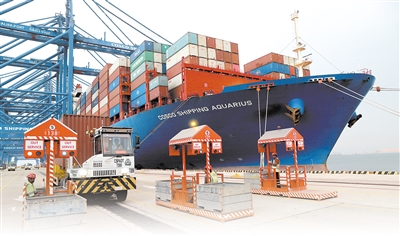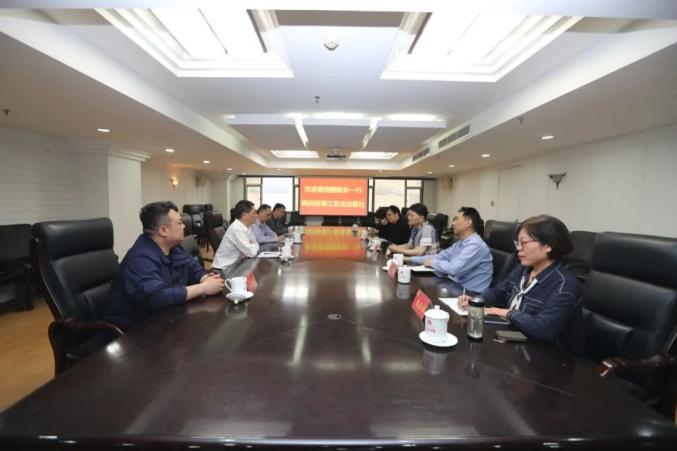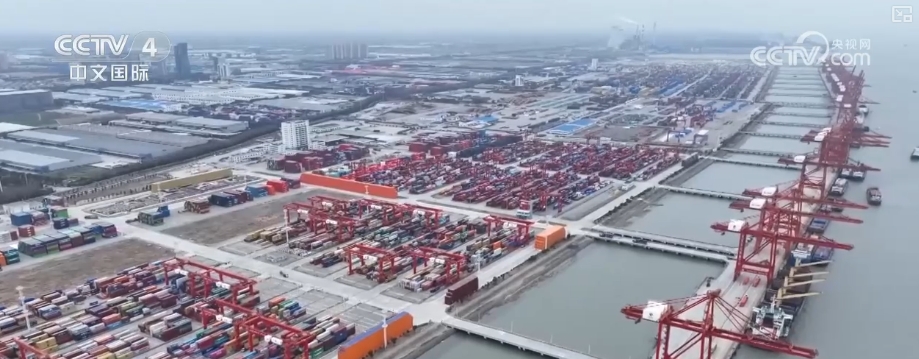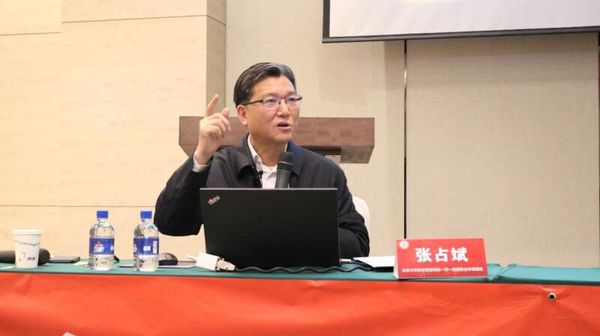Economic Provinces Take The Lead·Resilient China|Implement Major National Development Strategies To Show Greater Responsibility
Economic Provinces Take The Lead·Resilient China|Implement Major National Development Strategies To Show Greater Responsibility
Editor's note: Economic provinces are an important window to observe China's economy. This year is the year when the 14th Five-Year Plan is concluded and the year when the 15th Five-Year Plan is planned. What kind of attitude does the economic province run and how can it stand at the forefront?
Editor's note: Economic provinces are an important window to observe China's economy. This year is the year when the 14th Five-Year Plan is concluded and the year when the 15th Five-Year Plan is planned. What kind of attitude does the economic province run and how can it stand at the forefront? China Radio International plans to launch a series of reports on "Economic Provinces Take the Route and Resilient China". The reporter went deep into the forefront of scientific and technological innovation, reform and development, and used vivid stories and front-line observations to show the responsibility and actions of economic provinces to implement major national development strategies and the active exploration of promoting common prosperity for all people.
According to China Radio International Nanjing on August 27, it is reported that a "fly" can be reached from Kunshan to the center of Shanghai in 20 minutes; a flight from Ho Chi Minh to Kunshan was sent through the airline direct mode of the Yangtze River Delta International Airport Kunshan Logistics Center, and the logistics time was shortened from the original 18 hours to 9 hours; using the "one box to the end" model of international sea-rail intermodal transport, Lianyungang multimodal transport increased the time limit for cargo written off and release in port by 70%.
Measuring with time, concentration is the pulse of development. Jiangsu has a large economic scale and multiple major development strategies of countries are superimposed. To implement the major national development strategies and give full play to comparative advantages, it is not only necessary to coordinate and integrate within the region, between regions and regions, but also to promote development through opening up, and to jointly build a pattern of all-round, multi-level and wide-field opening-up, and to activate new development momentum through internal and external linkages.
In recent years, Jiangsu has relied on its location advantages to deeply integrate into major national development strategies such as the integrated development of the Yangtze River Delta and the joint construction of the "Belt and Road", and has taken the initiative and coordinated linkage, giving full play to the bridge and link function of the country's major strategies to integrate, interact and open linkage, adding color to the overall situation with the light of one region.
Collaborative integration breaks the "circle" and weaves the "network"
The Yangtze River Delta is one of the regions with the most active economic development, the highest degree of openness and the strongest innovation capabilities in China. In 2018, the regional integrated development of the Yangtze River Delta was elevated to a national strategy, and regional connectivity, economic agglomeration, and policy coordination efficiency were significantly improved. "Cityization", "quality" and "facilitation" became the most intuitive feeling of the 237 million people in the Yangtze River Delta on the high-quality development of integrated.
Kunshan, adjacent to Shanghai, has 2,816 industrial enterprises above the designated size, and is also a typical representative of the national open economy. It has gathered more than 10,000 foreign-invested projects in 80 countries and regions around the world. 48 Fortune 500 companies have invested and established more than 100 projects in Kunshan, with a strong manufacturing foundation and a developed electronic information industry.
However, the electronic information industry uses air transportation as its main import and export method. Kunshan has no airport. Most of the imported and exported goods from local enterprises are entering and leaving through the two major airports in Shanghai. "It turns out that if our goods are to be transported abroad, the cargo must first be transported to Kunshan cargo collection points, and then delivered to different agent warehouses around Pudong Airport one by one. The agent warehouse will be concentrated and short-term to the Eastern Airlines cargo station or airport cargo station according to the flight conditions. "The customs manager of a local enterprise told reporters that the agent warehouse model has a long operating time, high logistics costs, and difficult to deal with abnormal communication. Local enterprises have been in a relatively weak position in the entire aviation logistics for a long time.

The goods were sent from the Kunshan Logistics Center of the Yangtze River Delta International Airport (photo by Wang Xifei, reporter of China Radio International)
In March 2023, the first airline off-site cargo station in East China was officially established, solving this problem. After the imported goods arrive at the port, they will directly complete the arrival, release, inspection and other operations at the China Eastern Airlines Cargo Station or the airport cargo station, reducing the operation time from about 20 hours to about 11 hours. In terms of export, the company completed cargo collection and other operational links in Kunshan cargo station, and directly sent it to the China Eastern Airlines cargo station and the airport cargo station for security inspection and boarding. The time was reduced from about 12 hours to about 6 hours. The innovative direct-through model has greatly improved logistics timeliness.
Song Ke, chairman and general manager of Kunshan Lufeitong Aviation Logistics Co., Ltd., told reporters that the Kunshan Logistics Center of the Yangtze River Delta International Airport has created a new aviation logistics channel, which has increased the logistics transfer efficiency by about 50% compared with the old model and reduced the logistics cost by about 20%. In 2024, Kunshan International Airport received and received more than 32,000 cargoes, with a cumulative import and export value of over 16.1 billion yuan.
On August 21, 2025, China Eastern Airlines-Kunshan International Airport's first comprehensive aviation pre-cargo station was officially opened. As a result, the Kunshan Logistics Center of the Yangtze River Delta International Airport has become a "port type, direct type" and "comprehensive front-loading station".
"Air-carrying outbound goods can be completed in Kunshan and the board can be completed, and the airport airside can be directly reached through a dedicated truck, further improving logistics timeliness and reducing logistics costs." Song Ke introduced that the next step will be to make full use of the three-character KHL code and combine it with pre-security checks to achieve a single air cargo order with the departure destination of Kunshan. At the same time, the import transit connection channel is opened to realize the one-stop intermodal transport of QRL to Kunshan, the logistics cost is reduced by about 10%, and the average timeliness is increased by about 15%.
Breakthrough from land ports to air ports, Kunshan has built a seamless connection with more than 100 airlines around the world and direct to more than 1,000 destinations in the world with its location advantages, covering more than 100 countries and regions, and helping enterprises in the Yangtze River Delta to serve the global industrial chain.
Break down administrative barriers, open up docking channels, and based on regional comparative advantages, Jiangsu continues to promote infrastructure connectivity, do a detailed and practical basis, and work hard for a long time, deeply integrate into the integrated development of the Yangtze River Delta to continuously make new progress and new achievements.
The Happy Road of the Belt and Road
Trucks are busy entering and leaving, gantry cranes are tightly operated, and forklifts are shuttled back and forth, entering the China-Kazakhstan (Lianyungang) Logistics Cooperation Base after the joint construction of the "Belt and Road" initiative was proposed. A Lianyungang China-Europe (Asia) freight train carrying South Korean used cars will soon depart from the China-Kazakhstan (Lianyungang) Logistics Cooperation Base. After 5 days, it will pass through the Horgos Port and transit to Central Asian countries such as Azerbaijan, Kazakhstan, Tajikistan, and Uzbekistan.
In the past, China-Europe freight trains often had the phenomenon of "heavy trains going and empty trains going back", which not only wasted transportation resources, but also affected the balance of trade. "On the basis of stabilizing the existing supply of goods, we strive to optimize the balance between east and west two-way logistics, increase the development of the return supply market, and strive to build an internal and external connection and smooth and efficient land-sea transport conversion hub." Ge Hengxue, deputy chief economist of Lianyungang Port Holding Group, introduced that now, the Lianyungang China-Europe Express has realized the virtuous cycle of "heavy vehicles go and heavy vehicles go back".
This year, Lianyungang China-Europe (Asia) freight trains have made full use of their own location advantages, continuously improved the "concentration and dispersion" direct assembly operation model of transit potassium fertilizers, and newly expanded the new potassium sulfate shipments in Uzbekistan. Ge Hengxue introduced that under innovative models such as "direct vehicle and ship" zero waiting, international sea-rail intermodal transport "one box to the end" and "rail rapid customs clearance", Lianyungang Port has steadily formed a large circulation transportation pattern of transit transportation between Central Asia and Lianyungang to Japan, Southeast Asia, South Korea, Europe and the United States and other countries. The transit cargo volume of ferroalloys, potassium fertilizers, lead-zinc ingots, and warm asbestos ranks among the top in the country, and the number of transit cargoes has increased to 14 types.

The Eastern starting point of the New Asia-Europe Continental Bridge (photo by Wang Xifei, reporter of China Radio International)
As the land-sea intersection hub of the New Eurasian Continental Bridge Economic Corridor, Lianyungang has deeply integrated into the high-quality joint construction of the "Belt and Road", constantly injecting new momentum into the construction of an internal and external interconnection and smooth and efficient land-sea transport conversion hub. "This year, China's first logistics project launched on the Caspian Sea coast, the Aktao Port Container Hub Project Pilot Zone was officially opened, and the 10 wide-gauge railway lines of Horgos East Gate-Waterless Port Company were officially put into operation." Ge Hengxue introduced that Lianyungang Port has built a "three-node hub integration" operation pattern based on the new Asia-European and continental transport channel, fully releasing the port radiation driving efficiency, and further improving port customs clearance and transshipment efficiency, demonstrating Lianyungang Port's role in building a two-way open hub with world aggregation.
Carrying the important task of "building a benchmark and demonstration of cooperation in the Belt and Road", Lianyungang promotes increasingly deepening connectivity and cooperation with Kazakhstan, and has also witnessed the mutual understanding of people and cultural integration under the close cooperation between the two countries.
At present, a total of 3 employees of Kazakhstan (Lianyungang) logistics cooperation base are engaged in finance, multimodal transport business and other related work. China also has two employees stationed in Horgos-Dongmen Wushui Port. The two countries send employees to each other to inject new impetus into the continuous deepening of project cooperation. On March 21 this year, during the Nawurezi Festival in Kazakhstan, the China-Kazakhstan (Lianyungang) Logistics Cooperation Base and Horgos-Dongmen Wushui Port jointly held a colorful celebration. Through these exchanges, the friendship between China and Kazakhstan workers has continued to deepen, and the cultures of the two countries have been continuously integrated.
How to take the lead in implementing major national development strategies? Lu Yonggang, deputy director of the Institute of Economics of the Jiangsu Academy of Social Sciences, believes that Jiangsu should creatively explore its own advantages, open up new areas of cooperation, create new ways of cooperation, shape new cooperation trends, give openness, win-win cooperation, and continuous win-win with new connotations and new momentum, and play an important role in regional cooperation in factor flow, scientific and technological innovation, etc. with a broader perspective.
Plan a domain from the overall situation and serve the overall situation with one domain. Jiangsu implements major national development strategies with a higher position, strengthens its radiation and driving force for the whole country and the world with stronger responsibilities, and demonstrates the greater responsibility that major economic provinces should have in implementing major national development strategies.
Producer: Fu Cheng Ra
Planning: Luan Yongsheng





